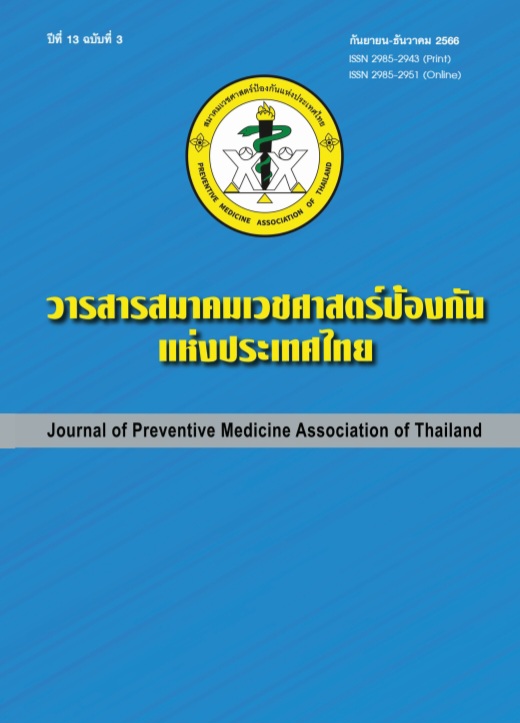Community Health Development Model to Reduce Sodium Intake in the Food of People, Chachoengsao Province
Keywords:
development model, community health, sodium intakeAbstract
Objective: The study basic information on sodium consumption, analyze and find components, experiment, and evaluate, and confirm community health development model to reduce sodium consumption. Methods: This research was a mixed methods research. The tools was Interview and a 5-level rating scale questionnaire. Data were analyzed using frequency, percentage, mean, and standard deviation. Verify elements with the consistency model using the LISREL program and a focus group. Results: Most people lacked sodium consumption knowledge. There should be efforts to educate raise awareness about sodium intake, communicate with people in the same direction, teach them how to use technology to search for information, and organize indoor and outdoor housing surroundings suitable to reducing sodium intake. Furthermore, there must be continual surveillance, monitoring, and assessment. 5 main components, 12 sub-components, and 63 indicators. The draft model was used to try it out. It was found that after the training the average was higher than before the training and all experts confirmed community health development model to reduce sodium intake in the food of people, Chachoengsao Province. It was appropriate and could been applied in real life. Conclusion: The community health development model to reduce sodium intake in the food: should start with health care behavior. Lifestyle and dietary changes reduce sodium in the diet. It is an important factor in prevention and reduce the risk of developing chronic non-communicable diseases.
References
กองโรคไม่ติดต่อ กรมควบคุมโรค. การบริโภคเกินไม่ได้สัดส่วน หวานเกิน มันเกิน เค็มเกิน. นนทบุรี: กองโรคไม่ติดต่อ กรมควบคุมโรค; 2554.
กองโรคไม่ติดต่อ กรมควบคุมโรค. ยุทธศาสตร์การลดการบริโภคเกลือและโซเดียมในประเทศไทย พ.ศ. 2559-2568. นนทบุรี: กองโรคไม่ติดต่อ กรมควบคุมโรค; 2559.
เจาะลึกระบบสุขภาพ. ขับเคลื่อนยุทธศาสตร์ลดเกลือและโซเดียม ตั้งเป้าคนไทยลดบริโภคเค็มลง 30% ภายในปี 2568 [อินเทอร์เน็ต]. 2562 [เข้าถึงเมื่อ 22 พ.ย. 2565]. เข้าถึงได้จาก: https://www.hfocus.org/content/2019/03/16920
อรรถเกียรติ กาญจนพิบูลวงศ์, ภาณุวัฒน์ คำวังสง่า, สุธิดา แก้วทา. รายงานสถานการณ์โรค NCDs เบาหวาน ความดันโลหิตสูงและปัจจัยเสี่ยงที่เกี่ยวข้อง พ.ศ. 2562. กองโรคไม่ติดต่อ กรมควบคุมโรค; 2563.
สำนักงานสาธารณสุขจังหวัดฉะเชิงเทรา. รายงานประจำปีงบประมาณ 2564 [อินเทอร์เน็ต]. 2564 [เข้าถึงเมื่อ 25 พ.ย. 2565]. เข้าถึงได้จาก: http://www.cco.moph.go.th/cco24/status/annual2564.pdf
กองโรคไม่ติดต่อ กรมควบคุมโรค. รายงานการสำรวจปริมาณโซเดียมในอาหารด้วยเครื่องวัดความเค็ม (Chem Meter) ปี 2565. กลุ่มพัฒนานโยบายระดับประชากร กองโรคไม่ติดต่อ กรมควบคุมโรค; 2565.
Krejcie RV, Morgan DW. Educational and psychologicrl measurment. New York: Minnisota University; 1970.
Patton QM. Qualitative evaluation and research methods. 2nded. Newbury Park, CA: Sage; 1990.
Strauss A, Corbin J. Basics of qualitative research: Techniques and procedures for developing grounded theory. 2nd ed. Thousand Oaks, CA: Sage; 1998.
Likert R. The Method of constructing and attitude scale. In Reading in Fishbeic, M (Ed). Attitude theory and measurement. New York: Wiley & Son; 1967.
Cronbach LJ. Essential of psychological testing. 5th ed. New York: Harper Collins; 1990.
สมรทิพย์ วิภาวนิช. การพัฒนารูปแบบการสร้างเสริมสุขภาพตามปรัชญาของเศรษฐกิจพอเพียงเพื่อสุขภาวะชุมชน [วิทยานิพนธ์ปรัชญาดุษฎีบัณฑิต]. กรุงเทพฯ: มหาวิทยาลัยศิลปากร; 2558.
สม นาสอ้าน, ทิพาพร ราชาไกร. การพัฒนารูปแบบการลดการบริโภคเค็มในกลุ่มสงสัยป่วยโรคความดันโลหิตสูง. วารสารสำนักงานป้องกันควบคุมโรคที่ 7 ขอนแก่น 2563;27(3):99-110.
สุรศักดิ์ กันตชูเวสศิริ. เตือน! บุฟเฟต์-หมูกระทะ-อาหารสำเร็จรูป คนไทยกินเค็ม ป่วย NCDs ทะลุ 22 ล้านคน [อินเทอร์เน็ต]. 2566 [เข้าถึงเมื่อ 10 มี.ค. 2566]. เข้าถึงได้จาก: https://www.hfocus.org/content/2023/02/26987
นุชธิดา สมัยสงฆ์. การจัดการด้านอาหารเพื่อป้องกันและลดความเสี่ยง ต่อการเกิดโรคไม่ติดต่อเรื้อรัง. วารสารพยาบาลสงขลานครินทร์ 2563; 40(4):122-30.
วลัยลักษณ์ สิทธิบรรณ์. การประเมินผลโครงการลดบริโภคโซเดียมในอาหารผู้ป่วยของโรงพยาบาลศูนย์และโรงพยาบาลทั่วไป เขตสุขภาพที่ 11 ปีงบประมาณ 2564. วารสารสภาการสาธารณสุขชุมชน 2565;4(3):69-80.
ยงยุทธ แก้วเต็ม, ณัฏฐ์ฐภรณ์ ปัญจขันธ์, วรางคณา สันเทพ, ไกรศร วงศ์ธิดา, ประดิษฐ นิรัติศรัย. ปัจจัยความสำเร็จและความล้มเหลวในการสร้างความรอบรู้ด้านสุขภาพเพื่อลดการบริโภคเค็ม ชุมชนบ้านป่าเหียง อำเภอเมือง จังหวัดลำปาง. วารสารวิชาการสาธารณสุขชุมชน 2565;8(1):28-44.
Downloads
Published
How to Cite
Issue
Section
License
Copyright (c) 2023 Journal of Preventive Medicine Association of Thailand

This work is licensed under a Creative Commons Attribution-NonCommercial-NoDerivatives 4.0 International License.
บทความที่ลงพิมพ์ในวารสารเวชศาสตร์ป้องกันแห่งประเทศไทย ถือเป็นผลงานวิชาการ งานวิจัย วิเคราะห์ วิจารณ์ เป็นความเห็นส่วนตัวของผู้นิพนธ์ กองบรรณาธิการไม่จำเป็นต้องเห็นด้วยเสมอไปและผู้นิพนธ์จะต้องรับผิดชอบต่อบทความของตนเอง






